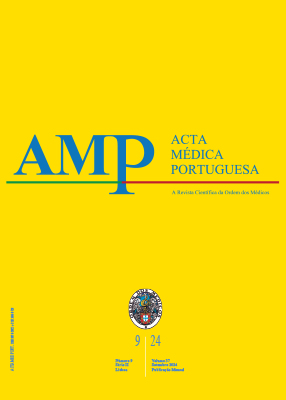Recommendations for Reducing the Environmental Impact of Inhalers in Portugal: Consensus Document
DOI:
https://doi.org/10.20344/amp.22062Keywords:
Administration, Inhalation, Carbon Footprint, Dry Powder Inhalers, Greenhouse Gases, Metered Dose Inhalers, Nebulizers and Vaporizers, PortugalAbstract
This consensus document addresses the reduction of the environmental impact of inhalers in Portugal. It was prepared by the Portuguese Council for Health and the Environment and the societies representing the specialties that account for these drugs’ largest volume of prescriptions, namely the Portuguese Society of Pulmonology, the Portuguese Society of Allergology and Clinical Immunology, the Portuguese Society of Pediatrics, the Portuguese Society of Internal Medicine, the Portuguese Association of General and Family Medicine and also a patient association, the Respira Association. The document acknowledges the significant impact of pressurized metered-dose inhalers on greenhouse gas emissions and highlights the need to transition to more sustainable alternatives. The carbon footprint of pressurized metered-dose inhalers and dry powder inhalers in Portugal was calculated, and the level of awareness among prescribing physicians on this topic was also estimated. Finally, recommendations were developed to accelerate the reduction of the ecological footprint of inhalers.
Downloads
References
United Nations. The human right to a clean, healthy and sustainable environment: draft resolution. 2022. [consultado 2024 mai 16]. Disponível em: https://digitallibrary.un.org/record/3982508?ln=en&v=pdf.
World Health Organization. Climate change and health. [consultado 2024 mai 16]. Disponível em: https://www.who.int/news-room/factsheets/ detail/climate-change-and-health.
Ribeiro HR. Poluição, um veneno silencioso para a saúde humana. Rev Ciência Elem. 2019;7:1-5. DOI: https://doi.org/10.24927/rce2019.069
United States Environmental Protection Agency. Climate impacts on human health. [consultado 2024 mai 18]. Disponível em: https://19january2017snapshot.epa.gov/climate-impacts/climateimpacts- human-health_.html.
Health Care Without Harm. Health care’s climate footprint. 2019. [consultado 2024 mai 16]. Disponível em: https:// noharm-global.org/sites/default/files/documents-files/5961/ HealthCaresClimateFootprint_092319.pdf.
Wilkinson AJ, Braggins R, Steinbach I, Smith J. Costs of switching to low global warming potential inhalers. An economic and carbon footprint analysis of NHS prescription data in England. BMJ Open. 2019;9:e028763. DOI: https://doi.org/10.1136/bmjopen-2018-028763
Jornal Oficial da União Europeia. Regulamento (UE) 2024/573 do Parlamento Europeu e do Conselho, de 7 de fevereiro de 2024, relativo aos gases fluorados com efeito de estufa, que altera a Diretiva (UE) 2019/1937 e que revoga o Regulamento (UE) n.º 517/2014. 2024. [consultado 2024 mai 19]. Disponível em: https://eur-lex.europa.eu/ legal-content/PT/TXT/PDF/?uri=OJ:L_202400573.
Keeley D, Scullion JE, Usmani OS. Minimising the environmental impact of inhaled therapies: problems with policy on low carbon inhalers. Eur Respir J. 2020;55:2000048. DOI: https://doi.org/10.1183/13993003.00048-2020
Khan N, Walpole SC, Rostkowska OM, Smith JN, Miller FA. Do clinical practice guidelines follow sustainable healthcare principles? A review of respiratory guidance. PLOS Sustain Transform. 2023;2:e0000078. DOI: https://doi.org/10.1371/journal.pstr.0000078
Usmani OS, Levy ML. Effective respiratory management of asthma and COPD and the environmental impacts of inhalers. NPJ Prim Care Respir Med. 2023;33:24. DOI: https://doi.org/10.1038/s41533-023-00346-7
Woodcock A, Beeh KM, Sagara H, Aumônier S, Addo-Yobo E, Khan J, et al. The environmental impact of inhaled therapy: making informed treatment choices. Eur Respir J. 2022;60:2102106. DOI: https://doi.org/10.1183/13993003.02106-2021
Wilkinson A, Woodcock A. The environmental impact of inhalers for asthma: a green challenge and a golden opportunity. Br J Clin Pharmacol. 2022;88:3016-22. DOI: https://doi.org/10.1111/bcp.15135
Alzaabi A, Bell JP, Montero-Arias F, Preço DB, Jackson DJ, Hao-Chien W, et al. Greenhouse gas emissions from respiratory treatments: results from the SABA CARBON International Study. Adv Ther. 2023;40:4836- 56. DOI: https://doi.org/10.1007/s12325-023-02663-2
Jeswani HK, Azapagic A. Life cycle environmental impacts of inhalers. J Clean Prod. 2019;237:117733. DOI: https://doi.org/10.1016/j.jclepro.2019.117733
Novartis. Case study: Breezhaler® Carbon Footprint. [consultado 2024 mai 21]. Disponível em: https://www.novartis.com/esg/environmentalsustainability/ climate/case-study-breezhaler-carbon-footprint.
Panigone S, Sandri F, Ferri R, Volpato A, Nudo E, Nicolini G. Environmental impact of inhalers for respiratory diseases: decreasing the carbon footprint while preserving patient-tailored treatment. BMJ Open Respir Res. 2020;7:e000571. DOI: https://doi.org/10.1136/bmjresp-2020-000571
Borenius K, Vartiainen V, Takala A, Haikarainen J, Parker G, Paronen N, et al. Life cycle assessment (LCA) and cradle-to-grave (CTG) carbon footprint of a multidose reservoir dry powder inhaler. Sheffield: European Respiratory Society; 2020. DOI: https://doi.org/10.1183/13993003.congress-2020.3183
Hänsel M, Bambach T, Wachtel H. Reduced environmental impact of the Reusable Respimat® Soft MistTM inhaler compared with pressurised metered-dose inhalers. Adv Ther. 2019;36:2487-92. DOI: https://doi.org/10.1007/s12325-019-01028-y
Janson C, Henderson R, Löfdahl M, Hedberg M, Sharma R, Wilkinson AJK, et al. Carbon footprint impact of the choice of inhalers for asthma and COPD. Thorax. 2020:75:82-4. DOI: https://doi.org/10.1136/thoraxjnl-2019-213744
National Institute for Health and Care Excellence. Asthma inhalers and climate change. [consultado 2024 mai 20]. Disponível em: https:// www.nice.org.uk/guidance/ng80/resources/inhalers-for-asthma-patientdecision- aid-pdf-6727144573.
Smith J, Bansal A, Barron-Snowdon J, Keeley D, Wilkinson A. How to reduce the carbon footprint of inhaler prescribing. [consultado 2024 mai 20]. Disponível em: https://s40639.pcdn.co/wp-content/uploads/ Reducing-Carbon-Footprint-of-Inhaler-Prescribing-v3.3.2.pdf.
PrescQIPP. Bulletin 295: inhaler carbon footprint. [consultado 2024 mai 20]. Disponível em: https://www.prescqipp.info/our-resources/bulletins/ bulletin-295-inhaler-carbon-footprint/.
NHS Business Services Authority. Respiratory - carbon impact dashboard [consultado 2024 mai 28]. Disponível em: https://www. nhsbsa.nhs.uk/access-our-data-products/epact2/dashboards-andspecifications/ respiratory-carbon-impact-dashboard.
Fulford B, Mezzi K, Aumônier S, Finkbeiner M. Carbon footprints and life cycle assessments of inhalers: a review of published evidence. Sustainability. 2022;14:7106. DOI: https://doi.org/10.3390/su14127106
Woodcock A, Janson C, Rees J, Frith L, Löfdahl M, Moore A, et al. Effects of switching from a metered dose inhaler to a dry powder inhaler on climate emissions and asthma control: post-hoc analysis. Thorax. 2022;77:1187-92. DOI: https://doi.org/10.1136/thoraxjnl-2021-218088
Beeh KM, Kuna P, Corradi M, Viaud I, Guasconi A, Georges G. Comparison of dry-powder inhaler and pressurized metered-dose inhaler formulations of extrafine beclomethasone dipropionate/formoterol fumarate/glycopyrronium in patients with COPD: the tri-d randomized controlled trial. Int J Chron Obstruct Pulmon Dis. 2021;16:79-89. DOI: https://doi.org/10.2147/COPD.S291030
PrescQIPP. Bulletin 295 - inhaler carbon footprint. [consultado 2024 mai 22]. Disponível em: https://www.prescqipp.info/our-resources/bulletins/ bulletin-295-inhaler-carbon-footprint/.
Ramadan WH, Sarkis AT. Patterns of use of dry powder inhalers versus pressurized metered-dose inhalers devices in adult patients with chronic obstructive pulmonary disease or asthma: an observational comparative study. Chron Respir Dis. 2017;14:309-20. DOI: https://doi.org/10.1177/1479972316687209
Campos L, Barreto JV, Bassetti S, Bivol M, Burbridge A, Castellino P, et al. Physicians’ responsibility toward environmental degradation and climate change: a position paper of the European Federation of Internal Medicine. Eur J Intern Med. 2022;104:55-8. 30. Campos L, Chimeno-Viñas MM, Carretero-Gómez J, Santos L, Cabrera- Rayo A, Valdez PR, et al. Recommendations of the Spanish-Portuguese internal medicine services in the fight against climate change and environmental degradation. Rev Clín Esp. 2024;224:162-6. DOI: https://doi.org/10.1016/j.rceng.2024.02.005
Downloads
Published
How to Cite
Issue
Section
License
Copyright (c) 2024 Acta Médica Portuguesa

This work is licensed under a Creative Commons Attribution-NonCommercial 4.0 International License.
All the articles published in the AMP are open access and comply with the requirements of funding agencies or academic institutions. The AMP is governed by the terms of the Creative Commons ‘Attribution – Non-Commercial Use - (CC-BY-NC)’ license, regarding the use by third parties.
It is the author’s responsibility to obtain approval for the reproduction of figures, tables, etc. from other publications.
Upon acceptance of an article for publication, the authors will be asked to complete the ICMJE “Copyright Liability and Copyright Sharing Statement “(http://www.actamedicaportuguesa.com/info/AMP-NormasPublicacao.pdf) and the “Declaration of Potential Conflicts of Interest” (http:// www.icmje.org/conflicts-of-interest). An e-mail will be sent to the corresponding author to acknowledge receipt of the manuscript.
After publication, the authors are authorised to make their articles available in repositories of their institutions of origin, as long as they always mention where they were published and according to the Creative Commons license.









